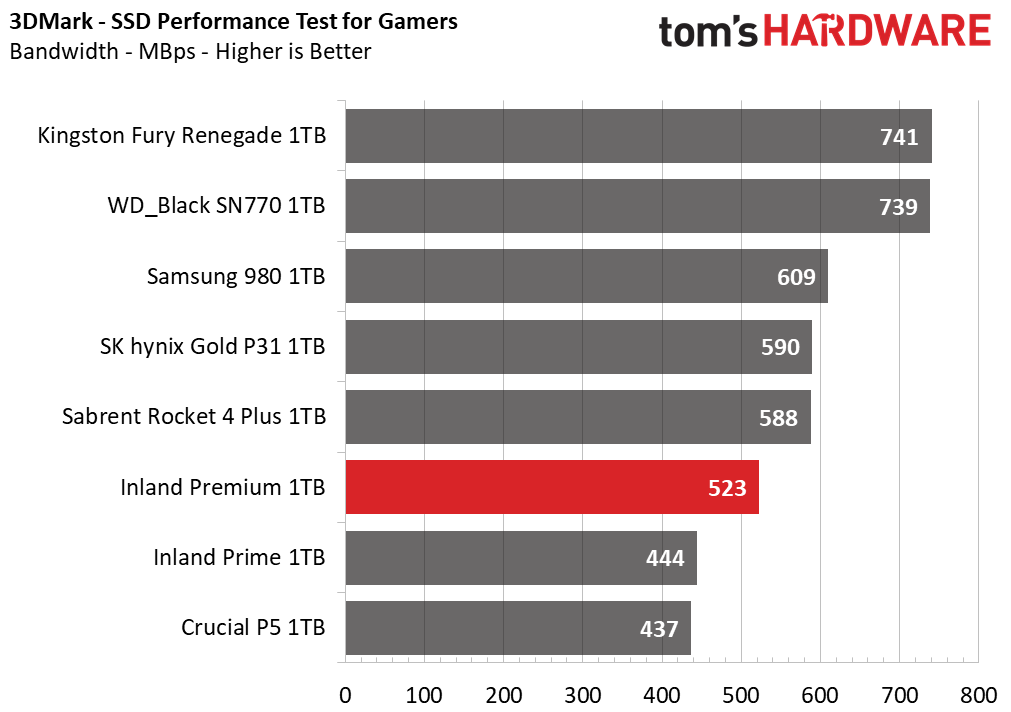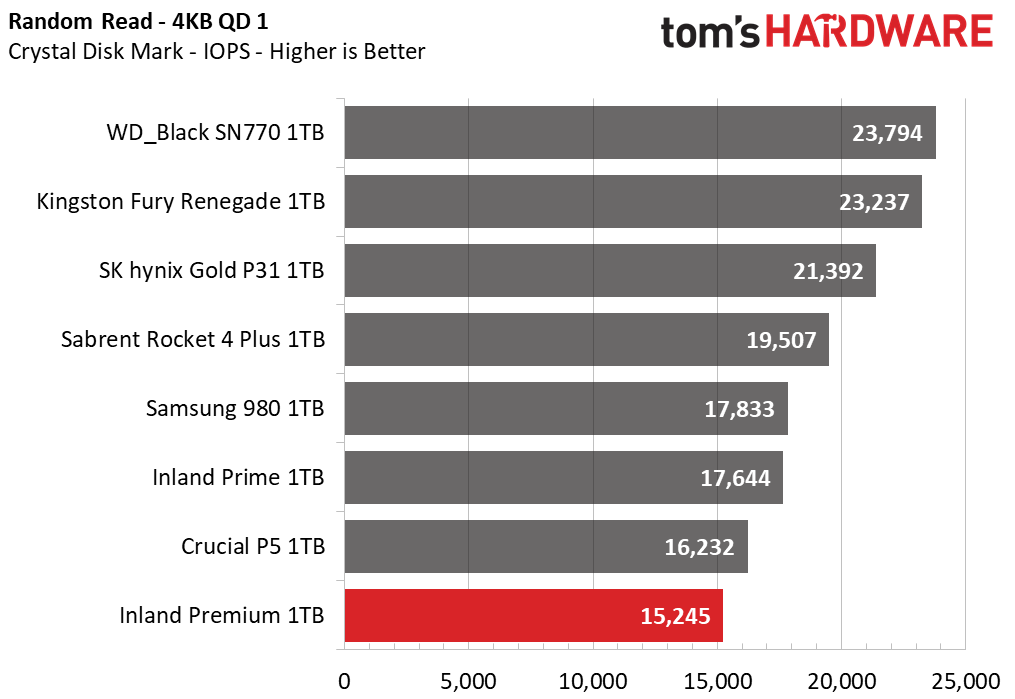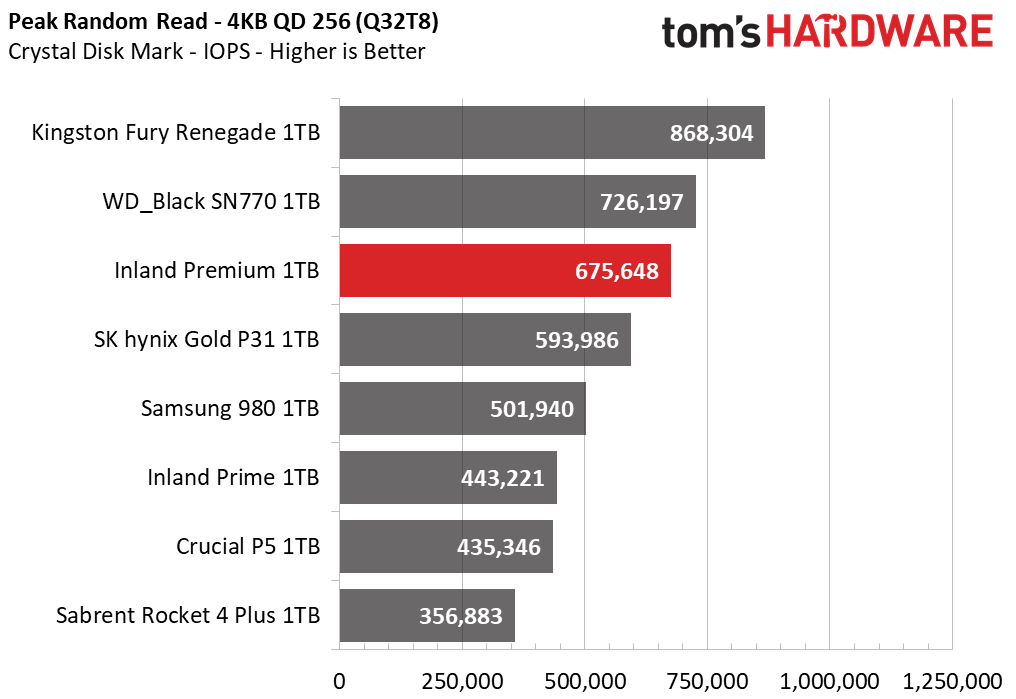Why you can trust Tom's Hardware
Comparison Products
We compare the Inland Premium 1TB to similar PCIe 3.0 drives like the SK hynix Gold P31, the Inland Prime, the Samsung 980, and the Crucial P5. PCIe 4.0 options include the Kingston Fury Renegade, the Sabrent Rocket 4 Plus, and the WD Black SN770. We have already tested many drives in this segment based on the E12/S and SM2262/EN. We want to see whether this configuration of hardware really makes sense given all the new options that are now available.
Trace Testing - 3DMark Storage Benchmark
Built for gamers, 3DMark’s Storage Benchmark focuses on real-world gaming performance. Each round in this benchmark stresses storage based on gaming activities, including loading games, saving progress, installing game files, and recording gameplay video streams.



The Inland Premium placed third out of eight in these tests, which is not hugely surprising. This test shows that newer DRAM-less solutions, like the 980 and SN770, can be effective.
Trace Testing – PCMark 10 Storage Benchmark
PCMark 10 is a trace-based benchmark that uses a wide-ranging set of real-world traces from popular applications and everyday tasks to measure the performance of storage devices.



The Inland Premium placed seventh out of eight in all of these tests, albeit performing very close to the P5. We see newer PCIe 3.0 drives like the P31 performing better, but again some DRAM-less designs demonstrate that you don’t necessarily need DRAM these days.
Transfer Rates – DiskBench
We use the DiskBench storage benchmarking tool to test file transfer performance with a custom 50GB dataset. We copy 31,227 files of various types, such as pictures, PDFs, and videos to a new folder and then follow up with a reading test of a newly-written 6.5GB zip file.


These tests are largely contingent on sequential bandwidth, clearly seen by the difference between PCIe 3.0 and 4.0 drives. How much is enough? For those that really want that burst bandwidth, PCIe 4.0 drives are the way to go. However, a fast PCIe 3.0 drive is clearly sufficient for most work. This arguably would include the Inland Prime.
Get Tom's Hardware's best news and in-depth reviews, straight to your inbox.
Synthetic Testing - ATTO / CrystalDiskMark
ATTO and CrystalDiskMark (CDM) are free and easy-to-use storage benchmarking tools that SSD vendors commonly use to assign performance specifications to their products. Both of these tools give us insight into how each device handles different file sizes.














In ATTO the PCIe 4.0 drives again stand out with the rest of the pack, mostly together at a lower threshold.
Variations in these output lines are not generally expected, but do sometimes show up. Flash is organized by 16 kB physical pages but there are multiple dies per channel over multiple channels, and each die also has internal parallelization through planes. With sequential writes it’s preferred to write in tandem, which means opening a larger superpage. Controller management interacts with knowledge of this structure such that performance anomalies sometimes appear.
CrystalDiskMark offers no surprises, but we are a bit underwhelmed by the Inland Premium’s weak random read results. Random reads, especially at low queue depths and with minimal if any threading, tend to be a relevant metric for consumer or everyday usage. There are many potential reasons why the Inland Premium might be weak here, but of consideration is the age of the flash. The other drives in this list all have newer flash.
Sustained Write Performance and Cache Recovery
Official write specifications are only part of the performance picture. Most SSDs implement a write cache, which is a fast area of (usually) pseudo-SLC programmed flash that absorbs incoming data. Sustained write speeds can suffer tremendously once the workload spills outside of the cache and into the "native" TLC or QLC flash. We use Iometer to hammer the SSD with sequential writes for 15 minutes to measure both the size of the write cache and performance after the cache is saturated. We also monitor cache recovery via multiple idle rounds.





The Inland Premium 1TB writes at a maximum speed of approximately 3 GBps for around eight seconds, suggesting an SLC cache size of around 24GB. This is typical of most E12S-based drives. This cache is dynamic in the sense that it will diminish in size when the drive is fuller. However, it’s relatively conservative in size and operates much like a static cache. This means that post-SLC performance is consistent and, further, the cache is very quick to recover.
The direct-to-TLC write speed is around 1150 MBps, and we see no prominent folding state. This drive will write for days straight, although its TLC is on the slower side compared to newer flash. DRAM-less drives tend to have slower post-SLC performance, and we see the Inland Premium can outwrite most drives given enough time. For shorter bursts, larger caches and PCIe 4.0 speeds will outdo the Premium. That being said, this drive offers respectable performance for writes.
Power Consumption and Temperature
We use the Quarch HD Programmable Power Module to gain a deeper understanding of power characteristics. Idle power consumption is an important aspect to consider, especially if you're looking for a laptop upgrade, as even the best ultrabooks can have mediocre storage.
Some SSDs can consume watts of power at idle while better-suited ones sip just milliwatts. Average workload power consumption and max consumption are two other aspects of power consumption, but performance-per-watt is more important. A drive might consume more power during any given workload, but accomplishing a task faster allows the drive to drop into an idle state more quickly, ultimately saving energy.
We also monitor the drive’s temperature via the S.M.A.R.T. data and an IR thermometer to see when (or if) thermal throttling kicks in and how it impacts performance. Remember that results will vary based on the workload and ambient air temperature.




The Inland Premium does adequately with power consumption, with a particularly good result in idle testing. Consumer SSDs spend most of their lives idle, although the exact power state being hit depends on the machine. Certainly, power consumption is more important when running on battery power, as with a laptop or UPS. We see that this drive is not particularly efficient with a file copy which, at the very least, demonstrates that newer flash is more efficient. This is especially true with newer controllers, including DRAM-less ones, for example, made with a smaller process node.
When monitoring the drive temperature under sustained load for about 150GB of writes, we recorded a temperature of 74C with FLIR and 70C via the SMART sensor. The drive’s first threshold is 75C, so it’s possible we were bumping up against it; that is, the drive could have been beginning to throttle. Drive temperature with normal workloads and proper case ventilation should not be a problem; however, this SSD got warm enough that we would recommend a M.2 shield or heatsink if possible.
Test Bench and Testing Notes
| CPU | Intel Core i9-11900K |
| Motherboard | ASRock Z590 Taichi |
| Memory | 2x8GB Kingston HyperX Predator DDR4 5333 |
| Graphics | Intel UHD Graphics 750 |
| CPU Cooling | Alphacool Eissturm Hurricane Copper 45 3x140mm |
| Case | Streacom BC1 Open Benchtable |
| Power Supply | Corsair SF750 Platinum |
| OS Storage | WD_Black SN850 2TB |
| Operating System | Windows 10 Pro 64-bit 20H2 |
We use a Rocket Lake platform with most background applications such as indexing, windows updates, and anti-virus disabled in the OS to reduce run-to-run variability. Each SSD is prefilled to 50% capacity and tested as a secondary device. Unless noted, we use active cooling for all SSDs.
Conclusion
The Inland Premium leverages a tried-and-true hardware configuration that’s been around for years in the typical E12S configuration. The amount of DRAM is less than typical but generally doesn’t hinder performance. There are no frills with this drive; for example, it comes without a heatsink or software. Its claim to fame is being widely available, particularly in Micro Center stores, with an extended six-year warranty. Why change something that works? This controller and flash combination is tested and true. For a long time, drives using this hardware configuration dominated the mainstream NVMe SSD market. With good reason - dozens of manufacturers put out drives using the E12/S or SM2262/EN controller. This generation of drives really made NVMe penetrate the consumer market after fits and starts with earlier drives like Intel’s 600p. Prices came down due to competition, not least as multiple types of flash were employed. Sabrent, for example, lists BiCS3/BiCS4/B27 on its page for its comparable Rocket. While swapping hardware has become an issue, the bottom line is that any user could pick up an affordable drive and have a reasonably good experience.
Inland is a good fit for this type of product as it’s easy to pick up storage in a Micro Center as part of a larger order, and it’s worth looking at how the old standard for SSD hardware holds up. We have discovered recently that newer drives — with 12nm controllers, faster bus speeds, newer flash and technology — really do offer all-new heights. “DRAM-less” used to be a bad word, but it’s clear that current and future drives can get by just fine with 64MB of host memory buffer in most cases, though there are certainly many caveats and exceptions. The point is that an older drive like this has stiff competition and must be priced accordingly.
As such, we feel the price is a little high, although the extra year of warranty is a nice bonus. We wouldn’t mind seeing Inland throw in OEM software or another goodie with these drives. There’s nothing special about this drive, but that’s not always a bad thing. However, there are likely better options for many users regardless of their priorities; this is more of a last-minute cart toss to add a bit of fast storage. We would love to give it a higher score, but similar drives have been as low as $85 at 1TB, making this a hard sell for those who can wait.
MORE: Best SSDs
MORE: How We Test HDDs And SSDs
MORE: All SSD Content

Shane Downing is a Freelance Reviewer for Tom’s Hardware US, covering consumer storage hardware.
-
Alvar "Miles" Udell Far better options at far better price tags. $424.99 for a 1TB NVMe drive is -insane-. A 2TB Samsung 980 Pro is half that.Reply -
vMax Okay maybe I have missed something or the price is a mistake. $429.99 for the Inland 1TB vs the Western Digital SN770 Gen 4 at $150 or even the Samsung 980 at sub $100!!!! I bought an ADATA Gammix S70 for just over a £100...Is this Inland drive something special for pro workloads or data centres?Reply -
SyCoREAPER Inland is fine for cheap accessories but I would never use them for data storage. They probably should have started off making RAM and building a reputation for more important computer parts first.Reply
As it stands, their accessories barely get a pass, so unless this is rebadged from a reputable manufacturer, hard pass. I'd go back to mechanical HDD before using an SSD or NVME from them if I had to choose. -
anonymousdude The pricing in the chart is really messed up. Nobody caught that before publishing?Reply
Also the Inland Premium line has been around for quite a while. At least 3 years at this point and has undergone multiple revisions. It used to be priced much cheaper than similarly performing drives. However, the pricing hasn't dropped as much competitors. So what used to be a great deal is now meh at best. In fact I remember during Black Friday 2019 the 2 TB drive was $215 when i picked one up.
Also to comment on the quality. I've never had an issue with mine. It started as a boot drive and then became my secondary drive after I got a 980 Pro. Pretty sure all the companies that elected an E12/E12s based drive just contract it out anyways so quality is similar between all those brands. If you pay a premium for one of them you're paying for looks, warranty, support, and the brand. Up to each individual if that's worth it.
